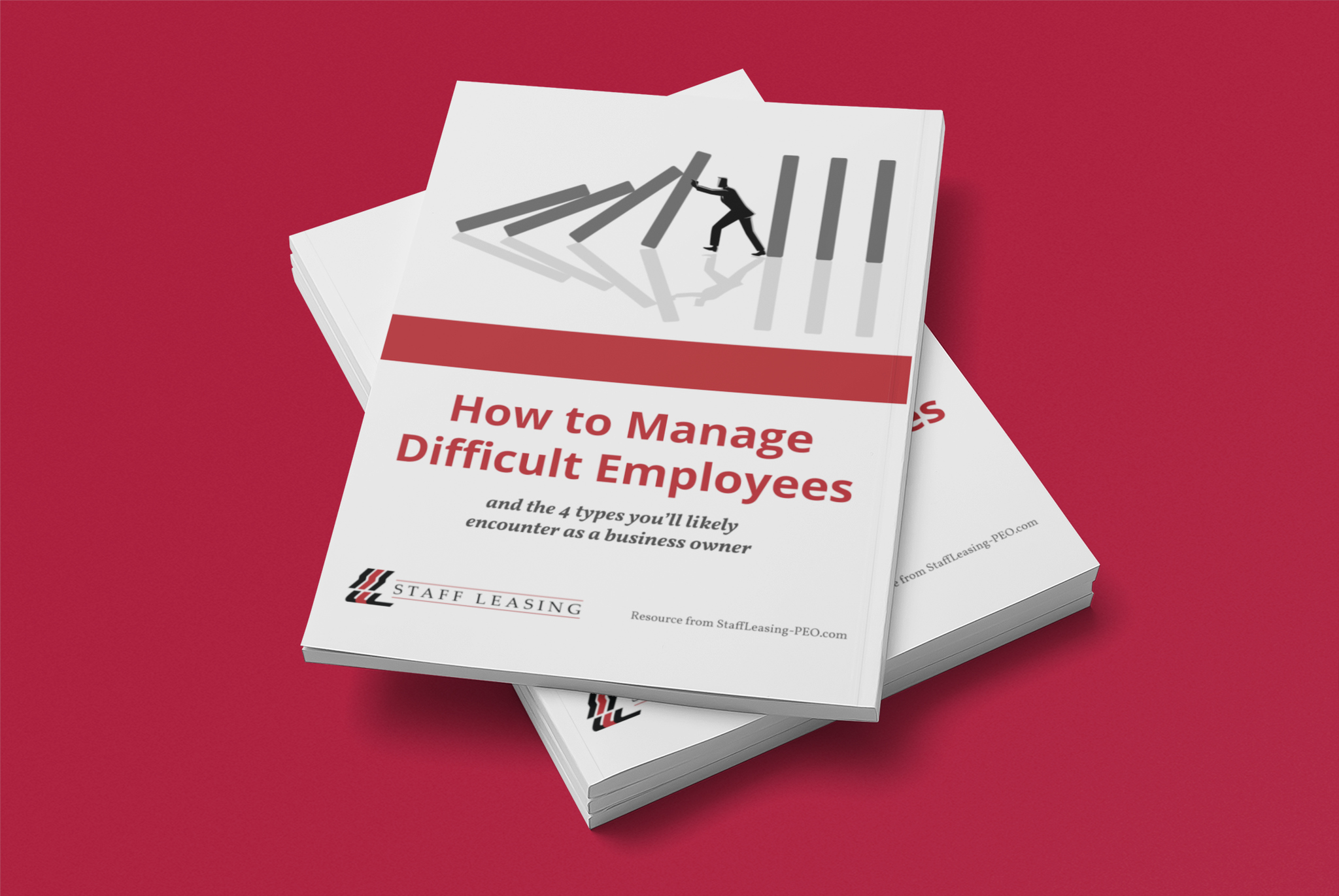Table of Contents
When you’ve worked hard to create a company culture that nurtures your workers’ best traits, it’s important to protect that culture. Some employees, while valuable members of your team, can present management challenges and conflict. Don’t avoid these management challenges; unresolved conflict harms productivity.
In this article, we’ll provide some guidance on how to manage difficult employees. We’ll also review 4 types of challenging employees you’re most likely to encounter, and strategies to help you effectively manage them.
First, some general tips for managing difficult employees:

Learn their strengths
Focus on finding the right fit between an employee’s strengths and the job they’re expected to perform. By finding the right fit, they’re much more likely to be successful. Sometimes, a “difficult” employee is simply in the wrong role. Help them establish career goals and develop a plan to achieve them. By discovering their true strengths and leveraging those skills, you’ll enable your employees to do their best work.
Identify the problems, don’t assume
Don’t jump to conclusions or assume you know what the real issues are. Open a dialogue with the person, and find out if they’re aware of their behavior and its impact on the team. If not, tactfully offer specific examples.
You should also consider the possibility that there are external, personal factors influencing your employee. There may be turmoil in the employee’s personal life, and they may not realize that it’s apparent at work. If this is the case, provide your employee with as many resources as you can.
However, don’t assume someone has an issue outside of work that’s contributing to their behavior. In that case, you may be cutting them slack when you shouldn’t be. Instead, uncover the root cause of the individual’s actions and work to address the issues. Once you get down to the basic problems and what may be causing them, then you can work to resolve those issues.
Stay calm, show respect
Managing your own emotions when dealing with difficult employees or situations plays an important role in how effective you are in your efforts. Set a positive tone from the beginning, and maintain that attitude. If you approach the situation with a negative mindset, you’ll likely find that your employees will get defensive and argumentative. Good leadership requires a balance of authenticity and compassion with professionalism.
More tips on having difficult conversations here
Provide actionable improvements
Once you determine the problem, then the appropriate tools and resources can be brought to bear. First, ask your employee to articulate what support they need to improve their behavior.
Remind the employee that a part of their job performance is measured by how well they contribute to the organization’s success. Any suggestions for improvement should be objective, measurable, realistic, and helpful. Typical solutions can include an employee assistance program, various training, executive coaching and other tools that might help the employee in areas where there may be gaps.
There is no one-size-fits-all solution. Tailoring your approach to the needs of an employee allows them the best chance for being part of a successful team.
Follow through
Once the tough conversation is through, underlying issues discovered, and a tailored plan implemented, it’s time to step back and monitor the progress. Measurable goals and a clear time frame to complete them are essential to proper follow up. All parties should have a clearly set and agreed upon timeline as their guide.
If the undesirable behavior continues, disciplinary action or even termination may be necessary. If you come to the conclusion that you must terminate the employee, here are 5 things to do first.
These are last-resort measures, of course. Hiring and onboarding are enormous costs for employers when compared to the price of effectively managing existing employees. The best possible outcome is to manage the employee in a way where they become more productive and exceed expectations.

The 4 types of difficult employees
“The Time Waster”
This is the person that tends to drag their feet and run out the clock most days. It seems that whenever there’s work to be done, they are nowhere to be found. Lunch breaks that tend to run long, going on coffee runs that take an unpredictable amount of time, or the one where everyone seems to wonder…”where did so-and-so go?” They are usually a distraction to others around the office whether it be lengthy personal conversations, sharing viral videos, or anything else they can think of to waste the work hours away.
Ignoring this behavior can discourage others that ARE respecting their work hours as they should. When addressing this employee, start with an open dialogue about any struggles they may be facing that are affecting their ability to be accessible and focused within the scheduled hours, and ask them to offer up any ideas they may have that could remedy the situation. While wasting time is unacceptable, they may be feeling overwhelmed or unequipped to get their work done and have resorted to procrastination in response to it. If the employee lacks passion or interest in their current role, try exploring some options of transferring them to another role that would be a better fit for everyone. After finding the root of the problem, set clear expectations for this employee and remind them that wasting work hours is a form of stealing and cannot continue without disciplinary action. You may need to enforce a strict time-clock policy with this employee to begin with or a daily log of work completed to ensure they are managing their time properly moving forward. Once you feel confident they have changed this behavior, you can give them another chance to work without these extra measures.
“The Victim”
The Victim has a way of making their situation anyone’s fault but their own. They seem to always have someone or something to blame for not getting their job done right or on time.
Make sure the conversation begins with open dialogue, allowing them the chance to express their experience. Sometimes the victim mentality stems from insecurity or the fear of failure. Simply offering up some words of wisdom or encouragement could help them understand that no matter the circumstances, they have the ability to use their skills and creativity to overcome them. It’s also important to clearly explain what they are accountable for. Accountability is important for the victim mentality as it designates the responsibility they must accept. Outlining this can help them prioritize and understand that excuses or blame are not acceptable for the tasks they are accountable for, and creates an easy way to follow up in a few weeks and recognize whether or not the problem was resolved.
“The Narcissist”
The Narcissist is someone whose world revolves around themselves. This can create myriad problems in the workplace as they normally don’t function well as a team player or in a leadership role. They can be brash, quick to pass judgement, and lack the ability to empathize with others in the workplace. Sometimes they can even manifest as bullies. This can be very toxic for the workplace and must not be ignored.
The first objective – are they aware of the way their attitude and actions are affecting the people around them? It’s important for The Narcissist to know how their actions are perceived by others. The goal is to have an open, constructive conversation without being accusatory or judgemental. Offer up any resources your HR department may have, like sensitivity training or emotional intelligence training, that could help them grow. Outline the expectation for improvement and set a clear goal for them to meet regarding this reform. Be sure to follow up with the employee and their coworkers at the end of that period to monitor progress.
“The Downer”
The Downer is an employee that seems to always cast a shadow of negativity or approach their work with pessimism. Challenges are usually more of a bother to them than an opportunity. Their attitude may even manifest as annoyance when work needs to be redone or an inconvenience arises. This attitude must be dealt with immediately as it can spread like wildfire.
Plan your approach on a case-by-case basis. This behavior may be a result of stress or personal issues, rather than a personality trait. Start by letting them know that you see a change in attitude, and that it’s having a negative effect on the team. Be sure to communicate that you care about their success, and make resources such as an employee assistance program available to them. Let them know their negative attitude is seen as a performance issue and discuss how this behavior affects the team, productivity, the company and their relationships. Be very clear about what’s expected, as outlined in your company policies. End with what will happen if their negativity continues.

Conclusion
Learning how to manage difficult employees is a necessary skill for any business owner. These strategies can help you navigate tough situations, and hopefully improve them before disciplinary action or termination is required.
Need help maximizing your employees’ potential? Connect with Staff Leasing and let our HR experts guide you.


